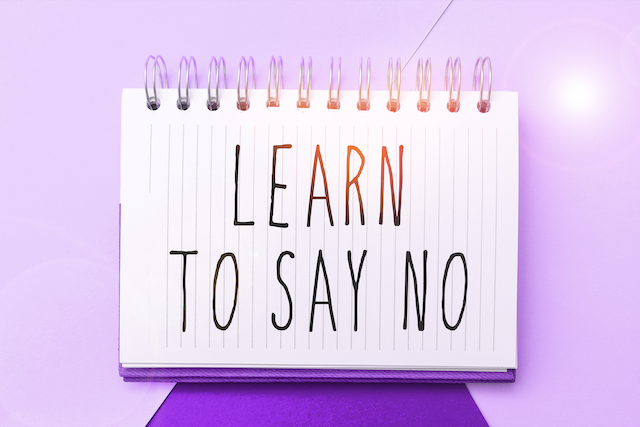
“Self-love, self-respect, self-worth: There’s a reason they all start with ‘self.’ You can’t find them in anyone else.” ~Unknown
Have you ever found yourself stuck in the “yes” trap, even when your gut screamed “no”?
I have.
We people-pleasers struggle with boundary crushers, and there are a lot of them out there continuously knocking over the barriers we put up!
But here is a secret I have learned: I’m allowed to say “no” without drowning in guilt. In fact, it’s a vital part of my self-care journey to give myself permission to freely say “no.”
Empowerment of “NO”
Saying “no” makes me, a people-pleaser, feel guilty.
I wonder, “Am I being selfish? Am I letting people down?”
It’s tough, but it is essential that I set firm boundaries to protect my time, resources, and mental health. Trust me, I need to look out for myself because nobody else is going to do it for me.
One of the most powerful tools I have at my disposal is the ability to say “no.”
It may seem paradoxical, but embracing the closed “no” has opened my life in a transformative way.
“No” Was Not Allowed
My people-pleasing ways were cultivated during my childhood when I was supposed to do as I was told, not question authority, and be compliant.
I was praised as being a good girl, an obedient child, the gold-star-sticker student.
Prioritizing others’ needs and desires over my own became the norm.
But here’s the big problem: Children do not stay little. We morph into adults.
As I grew and matured, it was difficult to switch gears to be able to stand up to bosses, romantic partners, and friends. It was easier to just give in.
But it didn’t turn me into a gold-star-sticker adult.
This constant self-sacrifice led to burnout, resentment, and a loss of my own identity.
Saying “no” is like reclaiming a piece of myself I’ve neglected for far too long. It seemed foreign at first, but practice has helped me harness the power of this miraculous word.
6 Ways I Say “No”
1. The Direct Approach
Picture this: A friend asks you to help them move on your only day off this month. You feel compelled to say, “Sure, I can do that.” But what if you just don’t have the time?
I will use the direct approach and say, “No, I can’t do that.”
I’m not required to give more explanation than that. No means no; that’s it. Initially, this approach felt uncomfortable to me because that isn’t how a good, obedient child should respond.
But I am not a child.
I’ve learned that being direct respects my own boundaries.
2. The Delayed Response
Sometimes, in the heat of the moment, it’s challenging to gauge whether a “yes” or a “no” is the right response. That’s where the delayed response comes in handy. It buys extra time to be able to think through the decision process.
For example, I had an old coworker who was always asking me to help with projects that weren’t my own. As a people-pleaser, I strive to make everyone happy, but I found that she soon began to expect my help.
I began utilizing the delayed approach by saying, “Let me look over my workload and get back to you on that.”
This allows me to avoid impulsively saying “yes” until I consider whether or not adding to my current workload is even possible.
3. The Grateful Decline
I went through a phase when I was obsessed with homemade cinnamon rolls. And they were amazing! But my recipe was one that took a couple days to complete because I had to allow time for the dough to rise twice over twenty-four hours. That, plus slicing and rolling individual rolls, made it very time consuming, although the results were worth it.
Well, people began asking me to make my “famous cinnamon rolls” for tons of parties and special occasions. Suddenly, my special-event-sweet-treat was being requested regularly. I appreciated the compliment but found I just didn’t have the time or energy to provide them for every party I was invited to.
This is where the grateful decline comes in handy. Instead of just simply saying “no,” I say, “I appreciate your thinking of me, but I can’t do it this time.”
This method shows gratitude for the request while respectfully declining. It’s a soft, sweet “no.”
4. The Alternate Offer
I had a neighbor who would occasionally ask me to help with her puppy when she had long workdays or extra meetings. I enjoyed the little guy and was happy to help.
But when my neighbor asked me to pet sit for a weeklong trip she was going on, I had to seriously think about my answer.
Puppies are a lot of work!
I knew I didn’t have the bandwidth to spend hours each day devoted to walking and playing with the puppy. Instead, I offered to take just one shift of puppy care per day. This allowed me to be helpful while maintaining my boundaries.
5. The Diplomatic Approach
I never want to hurt anyone’s feelings or appear harsh, but I still need to be able to say “no.”
Guess what? I don’t owe anybody a detailed explanation. This is when it’s important to be diplomatic.
As a writer, I get asked all the time to help with writing and editing. Sometimes I can, and do, help. But other times I just don’t have the time.
Someone I know recently asked me if I could help her college-aged student write a paper. I had a busy week, so I said, “I have too many other commitments at the moment.” End of story! I conveyed that my plate was full without making it personal.
6. The Empathetic Decline
Lastly, the empathetic decline allows me to acknowledge the other person’s needs and feelings while maintaining my boundaries.
A friend recently asked to borrow money. Usually a generous person, I am just not in a position to be able to give right now. I had to say, “I understand your need, but I have to say ‘no’ right now.” This response shows compassion while also respecting my own boundaries.
My Not-So-Secret Weapon
Learning to say “no” is my secret weapon in the quest to recover from people-pleasing. It’s not about being selfish or uncaring; it’s about establishing boundaries and regaining control over my own life.
Remember, saying “no” isn’t a rejection of others; it’s an affirmation of yourself and about valuing your time, energy, and well-being. Using these techniques has made setting boundaries less daunting and has freed me from the “yes” trap. Go ahead and embrace the power of “no,” and take control of your life.
About Lilly Strong
Lilly Strong is the creator of the LillyStrong blog and Youtube channel I Am Lilly, I Am Strong. Take a look at the Unveiled Narcissistic Abuse series, Magnet for Narcissists, Signs of Narcissistic Abuse, and How to Respond to 25 Gaslighting Phrases.













 Though I run this site, it is not mine. It's ours. It's not about me. It's about us. Your stories and your wisdom are just as meaningful as mine.
Though I run this site, it is not mine. It's ours. It's not about me. It's about us. Your stories and your wisdom are just as meaningful as mine. 